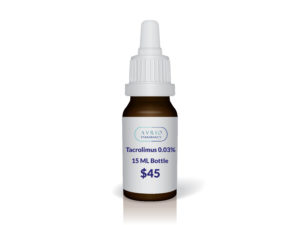 Tacrolimus
Tacrolimus
If your pet is blinking excessively, has swelling around the eyes, or is frequently rubbing her eyes, your pet may be suffering from dry eye. This condition may be caused by one of several common inflammatory conditions (KCS, CSK, etc.) that affect different parts of your pet’s eye. If you notice these symptoms in your pet, you should take your pet to see your veterinarian as soon as possible. For these inflammatory conditions that decrease tear production, tacrolimus is a likely medication your veterinarian may prescribe your pet.
What Is Tacrolimus?
Tacrolimus is an immunosuppressant designed to suppress the activity of T-cells. This suppression decreases the inflammatory response.
Why Tacrolimus Is Prescribed in Veterinary Medicine
Tacrolimus is most commonly prescribed by veterinarians to treat dogs that have been diagnosed with a dry eye condition secondary to immune-mediated inflammation. While not as common, tacrolimus is also used in cats. Additionally, tacrolimus may be used to treat a variety of topical conditions (atopic dermatitis, “hot spots”, anal fistulas, etc).
Dosage and Administration of Tacrolimus
Tacrolimus should be administered to your pet exactly as prescribed by your veterinarian. Do not touch the tube or container tip to your pet’s eyes, and do not touch the tube or container tip with your finger after applying the medication to your pet’s eye.
If you need to apply another eye medication, wait at least five minutes before doing so and apply all drops prior to ointments. If you miss a dose, then give the next dose as soon as you remember. If it is close to the next scheduled dose, then wait and resume with the next regularly scheduled dose. Do not administer a double dose.
For small dogs that are new to eye medications or difficult to apply drops to, you may consider wrapping them in a blanket or towel or distracting them with a treat (if their diet allows for it). For larger dogs it may help to have a second person hold your pet securely while you administer the eye medication. Positive reinforcement (treats, praise, pets), especially when beginning a new medication can make repeat doses easier.
It is recommended to wipe away any excess or residual that may pool in the fur surrounding your pet’s eye. Use a warm, wet disposable cloth to wipe the area while avoiding contact with the eye itself.
Special Precautions for Using Tacrolimus
Tacrolimus should only be administered to the pet that it has been prescribed for. Keep it out of reach of children and pets.
If skin exposure occurs, be sure to wash the area with soap and water. This medication is recommended to be handled while wearing gloves. If applying a topical ointment or cream, ensure your pet does not wipe the treated area on furniture or clothing. Children and pregnant women should avoid direct skin contact.
Possible Side Effects of Tacrolimus
Tacrolimus is generally well-tolerated as an eye drop. Common side effects include mild stinging/burning (this reaction usually decreases over time). Your veterinarian may recommend the use of artificial tears before and/or after the administration of this medication to help with this side effect.
While less common, fur loss around the eye and discoloration of the fur around the eye may occur. If you notice a change in your pet’s fur, contact your veterinarian. Routine cleansing of the area around the eye may prevent these side-effects.
Known Drug Interactions With Tacrolimus
Topical applications of tacrolimus are not known to have drug interactions. If you are applying multiple topical medications or your pet has an unrelated skin condition, consult with your veterinarian or pharmacist before starting this medication.
Proper Storage and Disposal of Tacrolimus
Tacrolimus should be stored at a controlled room temperature away from moisture, heat, and sunlight. Do not store it in the freezer or the refrigerator. If you notice the color of the medication has changed, or if it becomes cloudy or has visible particles floating in it, do not use it and contact your pharmacist.
For disposal it is best to take the medication to a drug take back program in your area if one is available. To dispose of this medication, remove it from its original container and mix it with an undesirable substance such as coffee grounds or cat litter. Put the medication in a sealable bag or container and dispose of in regular trash.

